A Topps Giveaway That Worked!
Topps Company has been tempting its customers with giveaways for a long time. The offers come to you in packs in the form of insert cards, each promising this, that or the other. I found the one you see on the left on the internet. It’s from1986, a mere twenty-six years ago. I have no idea what the odds of winning one of these things were back in the day, but they probably weren’t very good.
I’m not sure they’re any better now. You see, these days, Topps issues a lot of products. In addition to the standard Topps issue, their other issues include Topps Opening Day, Bowman, Bowman Platinum, Bowman Sterling, Bowman Chrome, Finest, Gypsy Queen and Allen + Ginter’s. I might have missed one or two, but so far that’s nine different issues. I don’t know how many of them come with special offers, but if I know Topps, I’ll wager the answer is quite a few. Topps will do anything to induce you, or perhaps I should say me, into buying more products.
So it was with a healthy dose of skepticism that I viewed the special offer insert cards I received in last year’s Topps baseball card packs. These were different from the ones I’ve received in the past. These came in a random fashion, rather than one per pack. The biggest difference was that each of these cards was a winner. That’s a change. All you had to do was go online, type in a code, and see what baseball card you won. Almost all of the cards were real, genuine Topps issued cards from the past, with the exception of a few, “Diamond Deed Cards” of Hall of Fame as well as current players. This seemed fair. Everyone who got one of the Topps Diamond Giveaway insert cards had the same chance to win a superstar, star, manager, coach, regular player, backup or “Diamond Deed” card.
I received thirteen “Topps Diamond Giveaway” insert cards last year. I went on line, typed in my codes and saw who I got. About three weeks ago, I contacted Topps and asked them to send me the cards, so after spending a mere $10.69 for postage + handling they were sent out. They arrived a few days ago. So how did I fare?
Four of the cards were of Hall of Fame players. Three of them were regular issues, including an ’87 Ryne Sandberg, an ’88 Mike Schmidt and an ’87 Reggie Jackson. This last card would have made my Mom very happy, even though it shows him as an Angel, because she always liked Reggie and often talked about how exciting the Yankees were when he played for them. She was on board the night that Mr. October hit three home runs in Game Six of the 1977 World Series, watching the game with Dad and me in the living room. I had a feeling the old girl was a closet Yankees fan, although she wouldn’t admit it with several Mets fans in the house. However, whenever Dad and I went to see the Yankees, Mom came to Yankee Stadium with us. She never once joined us on our treks to the Big Shea. At any rate, in her honor, I’ve inserted the Topps ’78 Reggie Jackson issue. I like this card myself because it gives a nice view of our star, with fans in the backgound and the red, white and blue A.L. All Star badge in the upper right-hand corner.
So what about that fourth Hall of Fame player? As luck would have it, I received a “Diamond Deed” Tom Seaver, my favorite ball player of all time. Holy cow! I could scarcely believe it. This is a great card for any Tom Seaver fan, but for me it was the holy grail! It sent me over to my Tom Seaver binder to count the number of his cards that I have. This new one brought the count up to 288 cards. The binder contains standard sized baseball cards (2.5″ x 3.5″) from Topps, Sportsflix, Fleer, Donruss, O-Pee-Chee, Leaf, Kelloggs, Hostess, Nestle, Coca Cola, Burger King, Star, Swell, Upper Deck and many other issuers. There are also mini’s, super’s and 5″ x7″ cards. None of them, however, were as unexpected as this one.
I didn’t even know about these Diamond Deed cards before I received mine. I’ve found a few things about them and am continually looking for more information. I know that over one hundred and fifty players are in this difficult to complete set. The players in it are Hall of Famers from the past and the stars of today. I’ve found a few of them for sale on the web, and the prices vary. On the high end are all-time greats such as Babe Ruth, Lou Gehrig and Hank Aaron, all in the $50 range. Outstanding young players such as Eric Hosmer and Stephen Strasburg are at least $40 and may fetch more. There’s a range of stars in the $20 and up range, such as Ichiro, Troy Tulowitzki and Starlin Castro. On the low end are everyday players who are going for about $8 each. Diamond Deed cards have a weird shape. The card is thick, with a shiny surface that glistens.
Getting back to Tom Seaver for a moment, I’m certain that picking only one “Diamond Deed” for a Hall of Famer of his magnitude wasn’t easy, I’m sure, because there are so many deeds to choose from. In this case, Topps chose well. On April 22, 1970, Tom struck out nineteen San Diego Padres batters, the last ten of them in a row. This is a staggering number of strikeouts for a pitcher to get in a regulation, nine inning game. However, since Tom’s accomplishment, the magic number of twenty strikeouts a game was reached by two pitchers, Red Sox ace Roger Clemens (twice) and the Chicago Cubs strikeout artist, Kerry Wood. However, since the modern era started in 1901 to this very day, only Tom Seaver has struck out ten batters in a row. The strikeouts were divided evenly, too, with five hitters looking, and five hiters swinging, at strike three.
I got an original “woody” as well, a 1962 Clay Dalrymple card. The first thing I thought of when I saw this card was that he was a member of the ’64 Philadelphia Phillies, the team that suffered a mighty collapse at the tail end of the season. If not for this collapse, Nan, you would not have seen the Yankees host the Cardinals in the Fall Classic with your friend Robin; you would have seen this Phillies team instead. However, with twelve games left in the season, and a six game lead over second-place St. Louis, the Phillies lost ten in a row, finishing a disappointing second. The card itself holds promise for me, because as a project one day I’m going to research who those players are in its background. Clay Dalrymple was a strong catcher and a good defensive player. He had some success offensively although he wasn’t known for that. He broke in with the big club in 1961 and came into his own in 1962, hitting .276 with 11 home runs. He even stole a base that season; maybe it was the power of the “woody? He was the Phillies regular catcher from 1961 to 1967. I saw him play during that stretch, and it’s exciting to receive a card of a player I saw play in a game over forty years ago. Dalrymple played out the balance of his career with the Baltimore Orioles from 1969 to 1971, appearing in the 1969 World Series against the Miracle Mets, and getting a hit every time he came to the plate against some outstanding Mets pitching. That’s a nice accomplishment for a ball player to have on his resume. Maybe I’ll think of that first the next time I view this card, because Clay Dalrymple was a very good player. I know that when people recall my career I would hope that they lead off with my hits rather than my misses. Like a lot of us, I’ve had plenty of both.
Perhaps I’ll ease up on Topps, too, because my haul of “winners” wasn’t over yet. This giveaway was really starting to shape up, as we’ll see when I pick up this topic again in my next post.

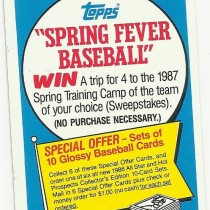
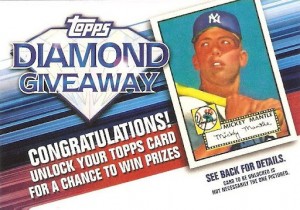
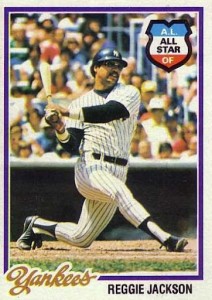
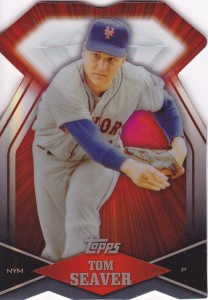
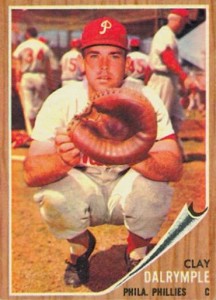
Comments